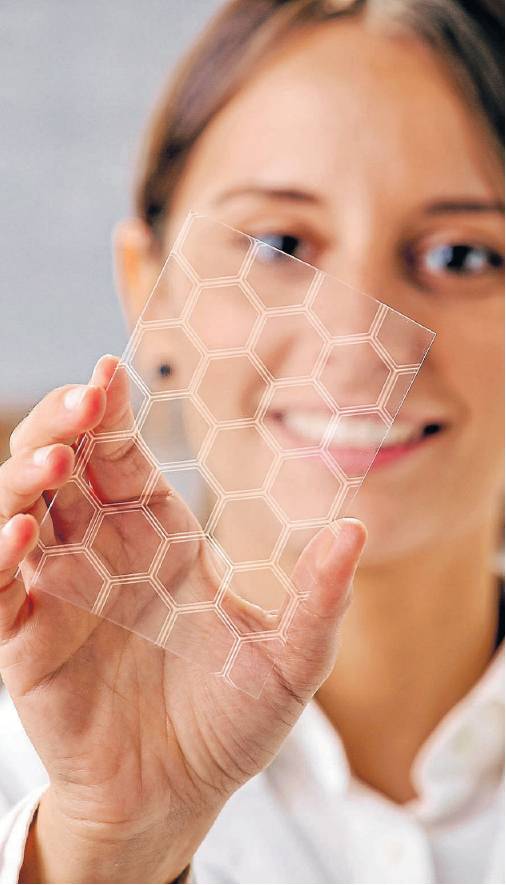ASX company eyes pivotal role in graphene
While investors pick winners in the lithium and nickel sectors, another ASX- listed company is positioning itself to benefit from the coming growth in the next wonder material.
Western Australia-based First Graphene Ltd plans to be at the centre of evolving demand for graphene.
It has acquired mining licences for high-grade graphite deposits in Sri Lanka, is among the first companies to set up a manufacturing facility in Australia to produce high-quality graphene in bulk quantities and is deeply involved in developing applications as well as a market for the new material.
Graphene, derived from graphite, is made up of a single layer of carbon atoms.
Discovered only in 2004, it has been hailed as a super-material for its attributes – it is 200 times stronger than steel, conducts 100 times better than copper and yet is more flexible than rubber.
An addition of 1 per cent of graphene by weight to other materials can result in dramatic enhancements of performance.
For example, it improves the tensile strength of concrete by 100 per cent; can improve plastic strength by up to 200 per cent; it can be used in paints and coatings as well as a fire retardant.
‘‘There is almost no end to the possibilities you can use it for if you do the nano-engineering,’’ says veteran analyst and First Graphene’s nonexecutive chairman Warwick Grigor.
Most of the graphene now being produced is through chemical vapour deposition or other nonscalable production techniques.
This has hampered its use, with large manufacturers such as Tesla or Samsung reluctant to use the material until reliable, commercial quantities are available.
The best estimates for the size of graphene demand range between 1000-3000 tonnes per annum, but industry experts are confident enough to predict annual growth rates of 60 per cent from this point.
This is where First Graphene hopes to make its mark, after setting up a low-cost manufacturing facility at Henderson in Fremantle, WA, where it can process rich graphite ore into graphene through the ‘‘electrochemical exfoliation’’ process. At full capacity, the facility can produce 100 tonnes a year.
‘‘The fact that we can do that clears a logjam that has been slowing down the growth of the graphene market,’’ Grigor says.
The company holds two industrial mining licences spread across 395 square kilometres of prime-vein graphite exploration areas in Sri Lanka. While the mines have been gradually developed over the last two years, First Graphene has been buying ore from mines run by the Sri Lankan government to now have two years’ worth of stockpiles at Fremantle.
Graphite is found all around the world, typically in 5-10 per cent grade ore bodies.
To derive graphene in commercial quantities from this would require mines of considerable size, and the construction of treatment plants to produce concentrate of 96 per cent or better.
On the other hand, the ore found in Sri Lanka is 97 per cent grade graphite, which doesn’t require any above-ground processing before it is shipped to WA.
Graphene potentially sells for a generic price of $100 a kilogram, with manufacturing costs of between $30 and $50/kg.
According to its preliminary estimates, if the company operates its Fremantle facility for a single shift, five days a week, it can produce 25 tonnes per annum, with a breakeven level at 18 tonnes/year.
Multi-shift production schedules would enable much higher production rates.
In its effort to have a presence across the value chain, First Graphene has set up a series of tie-ups with major Australian universities for developing intellectual property into applications, which it then hopes to licence to companies and manufacturers to earn royalty.
The tie-ups include a project with Swinburne University looking for applications into electric batteries; a project with Adelaide University examining the use of graphene in fire retardants; and an investigation into advanced graphene products with Flinders University.
‘‘Our job is to take what is happening in the universities into the industry.
‘‘We will not only produce the graphene, we will also guide industry on its applications, and what products to put it into,’’ Grigor says.
First Graphene has already sent samples to about 20 companies around the world for testing and engineering work to see how graphene can work best in their products. It expects some of these will advance to the point of sales contracts.
In addition, it is also working with global specialty metals marketing agency Traxys, to develop a structure for a third-party graphene market, for which it will be the largest independent supplier. ‘‘At the end of the day, you have got to be selling it, and that’s where we have our relationship with Traxys,’’ Grigor says. ‘‘They will be instrumental in advancing the marketplace that we will benefit from.’’
There is almost no end to the possibilities you can use it for if you do the nano-engineering.
Warwick Grigor, First Graphene
